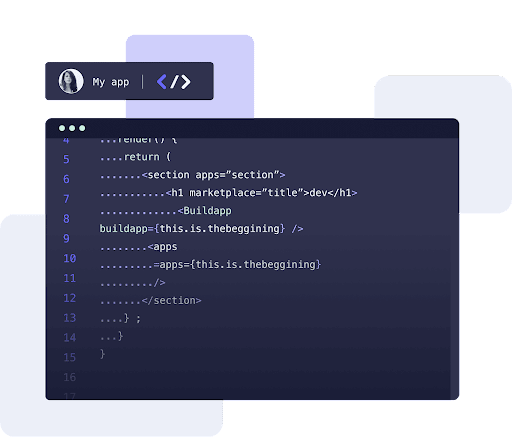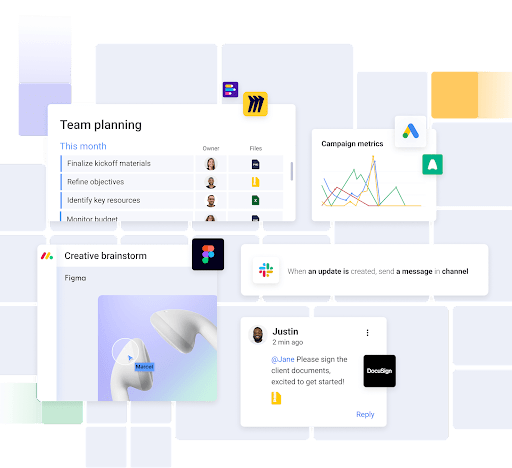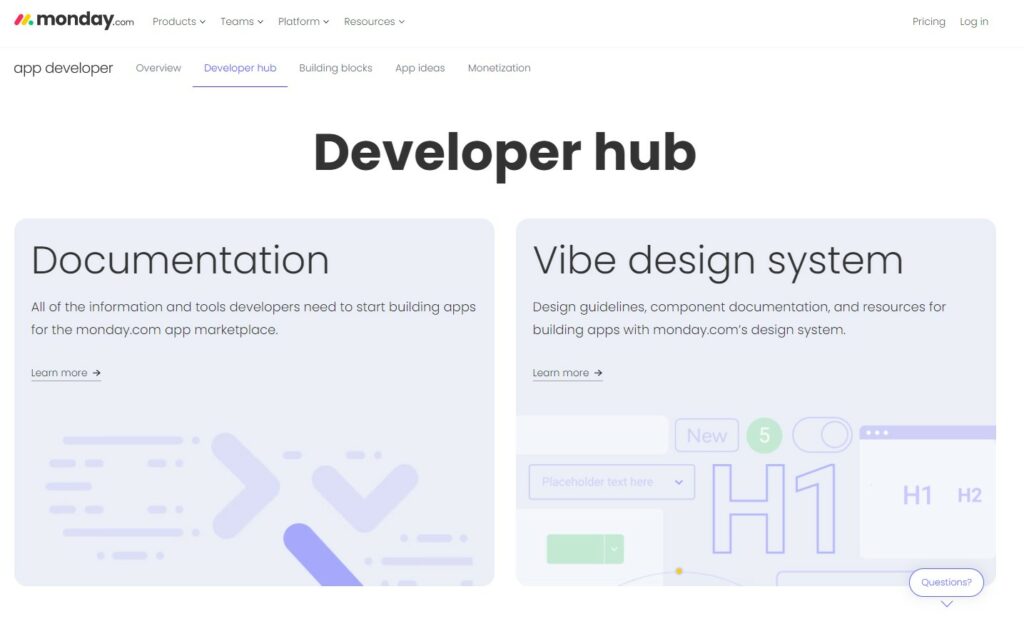With app marketplaces booming – and SaaS apps making up 70% of a business’s software – it’s a great time to build a marketplace app. Why? Because it’s lucrative for developers to generate revenue.
With low barriers to entry, such as leveraging existing tech and infrastructure to build quickly, a growing user base, and a huge diversification of products and services, there’s an abundance of opportunity to create a unique value proposition.
But, entering a space that already has 200+ SaaS marketplace apps may seem like a lot. However, it’s actually pretty small compared to other industries that have thousands of apps in their marketplaces.
Whether you’re a software vendor or dev agency, a solo entrepreneur, or product owner, or even a solo developer, there’s an enormous opportunity. Take a look at this article to see why and get the top six essentials to build a revenue-generating SaaS marketplace app.
Or you can join our developer community and start building with monday.com now.
Start buildingThe growth of SaaS marketplaces
According to Gartner, the SaaS industry has reached over $167 billion in 2022 – a staggering 5x growth in only seven years. The rise of SaaS marketplaces is a key reason for this uptick in growth.
With this in mind, let’s delve into how you can capitalize on this growth and monetize your own marketplace app.
Essentially, there are three stakeholders that benefit from marketplace apps:
#1: The SaaS provider
As a developer, you can integrate your third-party application within a SaaS provider’s tech stack to provide users with more choices. Essentially, it plugs a gap in their offering to allow users to work more efficiently within their workflows. With a solution that addresses their needs, users are less likely to be frustrated, and so churn reduces. Likewise, SaaS providers can better compete and attract new customers.
#2: The users
Whether it’s through the SaaS platform bringing in additional third-party tech or users directly seeking an integration, the best SaaS marketplaces allow users to find the right tech to solve a problem. Some platforms even encourage user feedback to inform marketplace app ideation.
#3: App developers
For developers, this creates a business opportunity because they can create these apps to sell-in to the SaaS provider directly, or via the SaaS marketplace. Users of SaaS products, like monday.com, are usually business customers who may invest large sums in tools to help them work more efficiently. When app developers work with SaaS platforms like monday.com, the users are already there and so the developer just needs to prove their app addresses a particular user demand and that it closes product gaps or expands its capabilities to address more use cases.
Sounds intriguing? Keep reading to find out the top six essentials to build a SaaS marketplace app, or you can start building with monday.com app marketplace now.
Start building
The top 6 essentials you need to build a SaaS marketplace app
For those looking to build a SaaS marketplace app, getting the essentials right is key. That’s why we have summarized the six key foundations to build a SaaS marketplace app:
- A good idea
- Market research
- The right skills
- Go-to-market plan
- Time and commitment
- The right SaaS marketplace platform
Let’s explore each, starting with the most important – a good idea!
#1: A good idea
With well-known software developers established in the SaaS industry, it may seem like penetrating the market is impossible.
However, there are always new emerging niches, pain points, and client demands that you can plug the gap with an app idea. And a successful SaaS app is one that’s underpinned by providing a unique solution – not available elsewhere – to address a target audience’s specific problem or pain point. Without this, SaaS apps are likely to fail because they just won’t get traction.
Equally important, as SaaS providers cover a range of target audiences – from marketing to HR through to IT – there’s quite a bit of opportunity there for an app developer.
Let me explain why with a few examples of how app developers are improving work management on monday.com:
- Expanding monday’s work management tool to completely new use cases/industries: For example, here’s an app that built an entire recruiting platform on top of monday.com.
- Deepening existing solutions on monday: Such as new sales visualization tools and development management software.
- Integrating external operational tools: Like Slack, Google Calendar, and Microsoft Teams.
In short, a good idea plugs a gap and addresses a clear need or pain point that the target audience has.
Looking for more inspiration? We’ve got the perfect next step for you. Check out our app development ideas board.
#2: Market research
If you want to build a SaaS marketplace app, it’s really important to get to know the trends in your target segment. And this requires extensive research and analysis to ensure your idea is viable.
In other words, you need to learn as much as possible about their pain points, needs, and concerns as you refine your SaaS app idea. If you checked out our ideas board, you’ll have seen a template that helps you to structure this.
From here, you can do a real deep-dive into existing apps to find any gaps and discover any opportunities to meet customer needs better.
On top of this, you need to assess the competition to make sure your solution is better and more attractive. And as part of this research, you’ll also want to consider pricing, marketing, and growth strategies.
Combined, all of this forms your unique and innovative SaaS app.
Keen to learn more? Take a look at this blog: 5 growth trends and best practices for SaaS marketplace app developers.
#3: The right skills
Let’s be honest here. Building a SaaS marketplace app is ambitious and requires the right tech skills. Luckily, most SaaS platforms are language agnostic, which means developers can build apps regardless of the programming language they use (Python, JavaScript, Go, Ruby on Rails, and more).
And some SaaS providers, like us, use GraphQL for its API. Plus, we have many resources in JavaScript and React. But also, developers who use other popular frameworks like Angular or Vue can also build great apps on monday.com (and do!).
Aside from coding skills, these are the key attributes of a successful SaaS app developer:
- Ability to capture insightful user research: And translate this user feedback into specific pain points in the product, so you can solve it.
- Product development understanding: So you can then design products based on the gaps identified through your user research.
- Strong platform knowledge: Basically, you need to know the SaaS tool you’re building on well, so you can tailor your app to the actual needs of users.
- Working knowledge of APIs and web development: To then be able to connect your app to the framework that the SaaS product gives you.
Looking for support? There’s no better place to develop these skills and ideas than with a community of like-minded peers. Take a look at our app developer community right here.
#4: Go-to-market plan
There’s no way around it. You need a business plan. But, instead of a 30-page plan, start with a one-page pitch. This is the fastest way to get your ideas down.
As a result, it’s much easier and iterative than traditional planning, and it is more suitable for SaaS businesses that are constantly testing new ideas.
Your one-pager should cover your idea, your audience, the pain points you will solve, how you’re going to do it, and who is doing what. It should also cover this crucial information:
- Release plan: Will you release a beta version initially, or go straight to a live version?
- App review process: SaaS marketplaces typically have an extensive review process before your app can be installed by their customers.
- Pricing: Will the app be free? Or paid? What features will it include in each tier? Will you set pricing tiers based on volume (usage, # of users), or feature set?
- Marketing: Successful apps aggressively build their brand/audience by engaging with potential users through communities, email campaigns, and even paid marketing on Google search, LinkedIn and more.
Related: Improve your tech sales process
With all of this information captured and in one place, you’re almost ready to get started.
#5: Time and commitment
As we’ve touched on, app development requires a multifaceted approach, as it involves so many different stages, such as ideation, research – and articulating this in the best way to sell your idea.
Rushing through this process risks not meeting users’ needs, or your app may underperform. In other words, don’t rush things. Why? Because marketing alone requires time and commitment. You need to consider how to present the app in its best way, clearly articulating the benefits in the marketplace. On top of this, you need to ensure you have a way to keep the app up-to-date.
Plus, you need to provide support to users – either directly or via self-service support, such as helpful articles and video tutorials.
Now, there is one shortcut you can take to develop a successful app in just a matter of weeks – not months.
The key is to choose to build your SaaS marketplace app on the right platform. For instance, monday.com’s developer portal provides developers with ideas based on users’ feedback. More on this here.
If you’re ready to explore our developer portal, you can get started now.
Start building#6: The right SaaS platform marketplace
Finally, as noted above, choosing the right SaaS platform is vital to the app’s visibility, user acquisition, and growth. So, when choosing the right SaaS marketplace, there are a couple of critical points to consider:
- Look for opportunities where you can make a business out of it: Platforms that already have paying business and enterprise users are a much safer bet – if they have a big enough total addressable market (as there’s a high chance they’ll pay for the app because it addresses their needs, like making work more efficient). You’ll want to check that there’s a demand for missing capabilities or known gaps that can be addressed with your third-party app.
- Check out platform readiness: Here, you’re looking for platform maturity so that you can build various solutions upon it – like APIs. Check out their developer hub to see what resources and support they offer. Plus, see if they have a community of like-minded developers you can chat with and learn from.
If your goal is to generate revenue, these two steps are essential.

Create a marketplace app so much faster with monday.com
One of our goals with developing monday.com’s app marketplace is to make building a marketplace much faster.
Sounds good? There’s more. We offer all the essentials off the shelf. A fully customizable app-building engine, the essential SaaS building blocks, a secure backend, and a powerful admin console. And that’s just the start.
Essentially, we’ve built a developer-first hub that makes it easier for developers to generate revenue from app creation.
What sets monday.com apart?
- monday.com and its marketplace are rapidly growing: There are more paying users who are willing to pay for marketplace apps. This means more business opportunities for app developers.
- Versatile platform: That can address endless work-related use cases across hundreds of industries – we aren’t limited to ecommerce, for example.
- Always developing: As we’re constantly improving our platform, there are many potential use cases and gaps that are not addressed yet.
- monday.com treats apps as first-class citizens: We can include apps in multiple locations on the platform and users will see apps right next to native functionality.
- Dedicated developer hub: Providing users’ feedback to spur ideas for new apps that solve an actual, known problem.
On top of this, we’re passionate about our users and our community. That’s why we’ve over 180,000 customers. In short, customers love monday.com and we’re always improving it.

You can get started now, or read on for the most frequently asked questions.
Start buildingFrequently Asked Questions
How to build a SaaS app?
There are six key steps to building an innovative and unique app that you can monetize:
- A good idea: Addressing a target audience’s specific problems with a solution that is better than what any other app is offering.
- Market research: Do a deep-dive into customer needs and competitor offerings.
- The right skills: As well as coding capabilities, strong skills in research, and product development are a must-have to set yourself apart.
- Go-to-market plan: Create a one-pager covering the essentials (your idea, audience, pain points, and how you’ll solve it). Plus, include your release plan, the app review process, and pricing.
- Time and commitment: Consider marketing, app upkeep, and user support.
- The right SaaS platform marketplace: SaaS platforms boost app success – providing they have a strong user base, you can identify a pain point, and the platform is mature.
How long does it take to build a SaaS app?
On average, it is said to take between at least 2-10 months to build a SaaS app. But, at monday.com, we’ve seen it take just a few weeks to build a fully operating product that is ready to monetize in the marketplace. But here’s the typical app development lifecycle and how long it takes:
- Defining what your app will do: This usually takes around a week. You can do this quickly by using our monday community for ideas.
- Actual development: Typically 1-2 weeks for a simple app (which is what most teams commit for their first app).
- Review and marketplace approval process: This takes around 1 month. But, most of this is waiting for the app developer to update their app. Therefore, it can be faster if the developer is engaged and responsive.
Can you create a SaaS without coding?
If you’re a solo entrepreneur, for example, then the simple answer is yes. You can outsource this side, but a word of caution: it will eat into your profits. App developers with strong coding skills stand a much greater chance of building a successful SaaS app. There are so many programming languages you can use. If you’re not a proficient coder, but you’re a product owner with business orientation and tech understanding, then you can outsource the dev work. Top tip: Consider teaming up with a coding pro from an app developer community.
Simplify app development with monday.com
To wrap up, if you’re serious about building a SaaS marketplace app, then it’s worth looking at monday.com. Our apps are built with a GraphQL API. This flexible query language means that you can return as much or as little data as you need. Plus, everything else – account data, board views, widgets and more – are all included in monday’s Software Developer Kit (SDK).
On top of this, the monday.com SDK provides a toolset for application developers to build features and solutions on top of the monday.com Work OS platform.
You’ll find this SDK useful if you want to:
- Access monday.com account data from your application by utilizing the GraphQL client.
- Build board views and dashboard widgets that extend the monday.com UI.
- Build integrations and automations using your own external services and business logic.
And, if you have any issues, you can always contact our dev success team by posting in our developer community.
Find out more or get started now.
Start building
